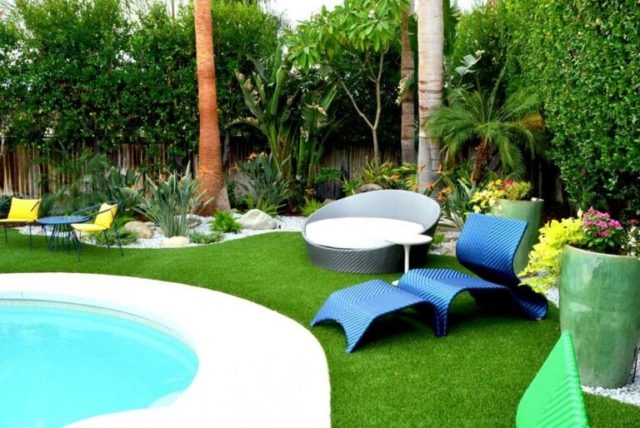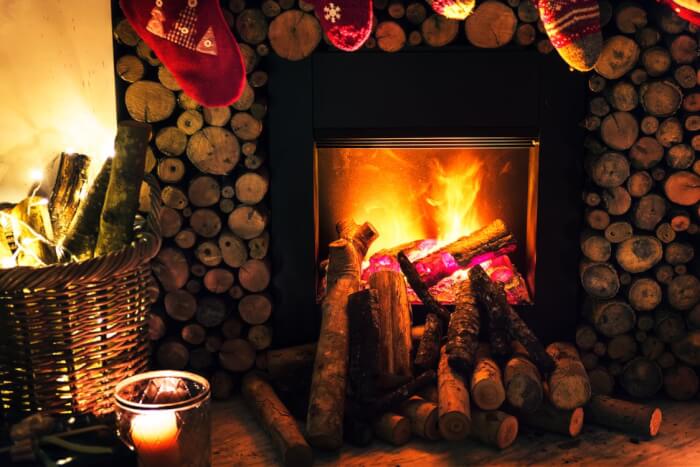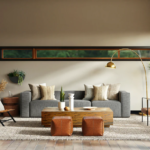Landscaping around the pool is an important project, as it can significantly affect the appearance of your yard. In most cases, homeowners opt for natural stone or grass around their swimming area to preserve its natural appearance. That may seem logical, but you’ll realize over time that aesthetics are not the most important thing in pool surroundings.
Check the following page for different pool models you can have in your backyard:
https://www.bhg.com/home-improvement/outdoor/pools-spas/types-of-pools/
Natural grass is susceptible to heavy traffic and water damage due to splashing. And when moisture gets inside, it can’t drain fast, thus becoming a haven for bacteria and allergens and causing damage to the filtration system. Also, not to mention how slippery and dirty grass can be.
On the other hand, artificial turf is super durable. It can endure the elements and is not prone to wear and tear. Plus, it doesn’t need to be mowed often, so it can look beautiful all year long. Also, synthetic turf offers dedicated drainage, which makes it a much safer option than any other material for pool surroundings.
So, after knowing all the good sides of artificial turf, it’s time to find the one that suits your needs and design requirements. First, of course, you have to consider several factors, but probably the crucial ones are how much traffic the pool area will receive and its size.
Grass Pile Height
The pile height of the artificial grass is the first factor to consider. It can affect the overall look of your patio and the entire yard. But it’ll also affect the pool surrounding maintenance needs. For instance, the lower the pile height, the easier it’s to maintain and clean.
Also, if you have pets, a shorter pile height will keep them from destroying your landscaping. Of course, choosing a low grass height is also possible for decorative purposes. But if you aim for a lush and luscious appearance, you’ll want to choose a higher pile height than if you’re trying to keep the pool area free from puddles.
Typically, you’ll find that it’s best to choose a pile height between 25 and 45 millimeters. That’s usually lower than natural grass piles, but it still provides adequate traction. Moreover, it won’t flatten out as quickly as natural grass does. Finally, shorter artificial turf offers the best balance of practicality and aesthetics.
Density
Before installing artificial turf near pools, you need to determine the size and shape of that area, but also the traffic it’ll endure. That will help you choose the pile density of synthetic turf. But in general, the denser it is, the better. Experts suggest about 16,000 stitches per square meter for pool surroundings.
Dense piles will make the grass look lush and protect pool visitors from slipping or falling, providing excellent cushioning when barefoot. Thick turf will also prevent dust from blowing onto the surface. It will also reduce the risk of pets damaging the grass.
Turf Materials
Planning the area around your pool will help you determine the best materials and installation methods for the synthetic turf you choose. Synthetic fibers are different than those of natural grass. Some are softer, while others are thicker.
Of course, their quality will depend on the material they’re made of. Generally, the best turf products will resist matting and provide a realistic look. Also, you want to choose a material that can allow water to drain quickly and efficiently. In that case, a nylon and polyethylene blend is what you need.
It’s a perfect combo of softness and firmness, certified by independent organizations and tested to ensure it’s free of harmful materials. At the same time, it will keep grass piles straight and provide a comfortable feel underfoot.
Sub-Base Materials
Before installing artificial grass for pool surrounds, you should consider the backing material you want. High-quality materials keep the turf in place and handle heavy traffic and garden furniture. Also, they should be 100% permeable to drain much more quickly. Find out on this source how to drain pool deck efficiently.
Good choices are sub-bases made of decomposed granite or limestone chippings. These two materials will provide maximum drainage capacity. On the other hand, you might want to avoid sharp sand when laying the course of the artificial grass. It could wash away easily under heavy drainage.
The best thing you can do is to look for backing materials with a minimum of 900 grams of heavy-duty latex per square meter. They should also be UV and fire-resistant. In any case, these materials should be certified and tested to withstand different types of stress.
When choosing artificial grass for your pool area, you should ensure it’s durable, good-looking, durable, and highly resistant to chemicals and harsh weather. It should also have a non-slip surface and good drainage to make walking on it comfortable and safe.











